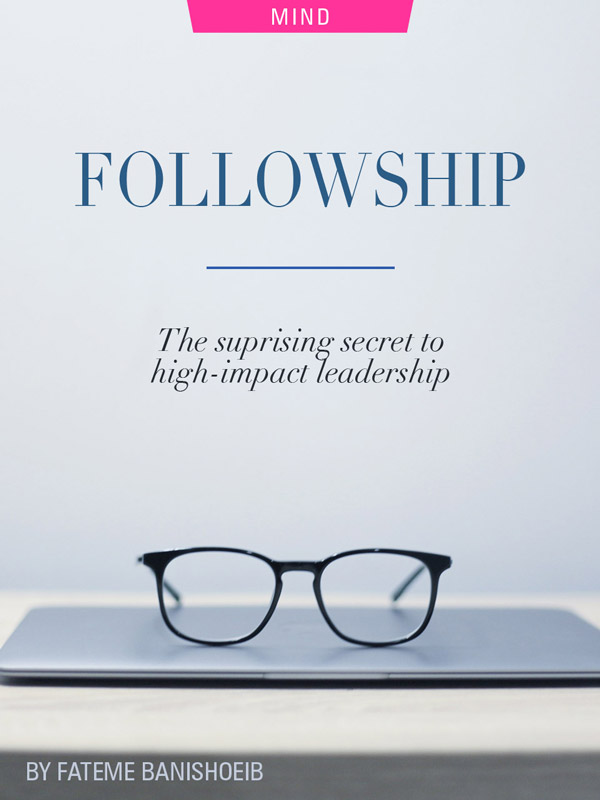The surprising ingredient for successful leadership is followship — and embracing this construct can optimize both your professional and personal life
—
The construct of leadership is instilled in us at a young age — the coveted position at the head of the line. Accompanying it, is the leading myth that it is something appealing, a sign of worth, an absolute to aspire toward if we want to succeed in life. Leadership is constantly under the shining lights of our attention and dreams — perhaps our definition of it needs to be reconstructed.
Think, for example, of how many programs there are for leaders: future leaders, female leaders, agile leaders, you name it. Maybe you’ve heard of and even attended some. But I ask you, is there a program for ‘followers’? Have you ever heard anyone being proud of being considered a follower? Probably not.
So many of us get uncomfortable around the concept of ‘following’ — to the extent that we are even reluctant to follow our own desires, claim our dreams, heed our intuition. Why? Because we live in a productivity-driven, fast-paced world obsessed with ‘leading’ — or following someone else’s professional path. Where do you and your skills fit into this equation?
The modern day conundrum: In order to appear successful, one must LEAD…not follow, right?
The question then is: Can we really dare to lead others without being able to follow our own SELF?
Sometimes that means leaning in, in more ways than one.
I found myself reflecting on this topic when applying for a speaking engagement for a global conference. I looked back upon my own career path with its seemingly endless list of leadership programs attended. I remember leadership meetings created to discuss succession plans and to identify the company’s future leaders. Not once, can I recall anyone being identified as a follower and it being remotely associated with a compliment. Admittedly, I myself would have been offended had I received feedback identifying myself as a ‘follower’.
But I think we’ve got this all wrong — and I think we are doing ourselves and others a real disservice in doing so. We can’t all be leaders in this traditional sense, nor should we try. It’s essential to be flexible in our definitions of the word.
How would our approach to leadership change if we could consider ‘followship’ instead, as an integral part of becoming a more formidable leader? Followship being defined as possessing the ability to be both present and centered, following one’s purpose and aligning actions around it. When we do not follow our own self, we ultimately face the consequences of disconnection, lack of joy, we might even end up getting the coveted corner office and yet resent it, because we are no longer happy or able to discern “why” we are doing what we are doing. In other words, we lose ourselves in the process of becoming something that isn’t innately aligned with the core of who we are.
We lose the capacity to lead ourselves and others when we are not following ourselves. We lose the capacity to lead change because we have lost our North Star and can’t navigate the unknown sea of what we call the VUCA world the acronym for volatility, uncertainty, complexity, ambiguity.
It is time we acknowledge that there is no separation between leadership and followship; they are the two sides of the same coin that present a fullness — a whole picture perspective.
We cannot be one without being the other if we want to be whole. The most revolutionary thought to keep in mind is that we each possess the essence of both leaders and followers — just as a coin is still a coin, regardless of which side we see.
Learning how to become a better leader requires embracing our inner follower. There are plenty of studies and articles on the skills and recipes to becoming a better leader.
As a counterbalance, here is mine for becoming a better follower:
- Be curious about yourself
- Listen to your deep desires and emotions
- Follow both your mind and heart in an act of inclusion of your whole humanity
When we fail to acknowledge the value and true meaning of following and leading, we fall into fragmentation, isolating a powerful part of ourselves that, in order to be compensated, leads to tyranny. There is a time and place for all things — a time to use certain tools and a time not to.
One sign of lacking an ability to follow can show up as resistance. To develop a stronger sense of followship I invite you to resist less, especially in a moment of conflict. During those moments, ask yourself:
How can I look deeper beyond the obvious elements of conflict, to better understand what the concerns, priorities and currencies of the other are?
How can I focus on staying present and centered in the workplace?
How can I stay supple and agile within my professional life, like flowing water over rocks?
The purpose for this is twofold. When we stop resisting (ourselves and others), we begin to notice more; we become more skillful in building trust in all that we come in contact with. When we withdraw (or aggress), when we do not listen and lose contact with our heart — how empty our chest feels?
The confusion, lack of clarity, and lack of grounding that comes when we lose touch and become unable to follow our own self are the enemies of leadership. Follow your heart back into your true leader.
This is my poetic gift for you from my book, The Whisper: Lyrical Conversation With The Multitudes:
Born with wings
I was born with wings to learn the difference between strength and softness
I learned strength
To fly I have to learn softness
You may also enjoy reading 4 Leadership Lessons from the (Surf) Board by Eric Kaufman

